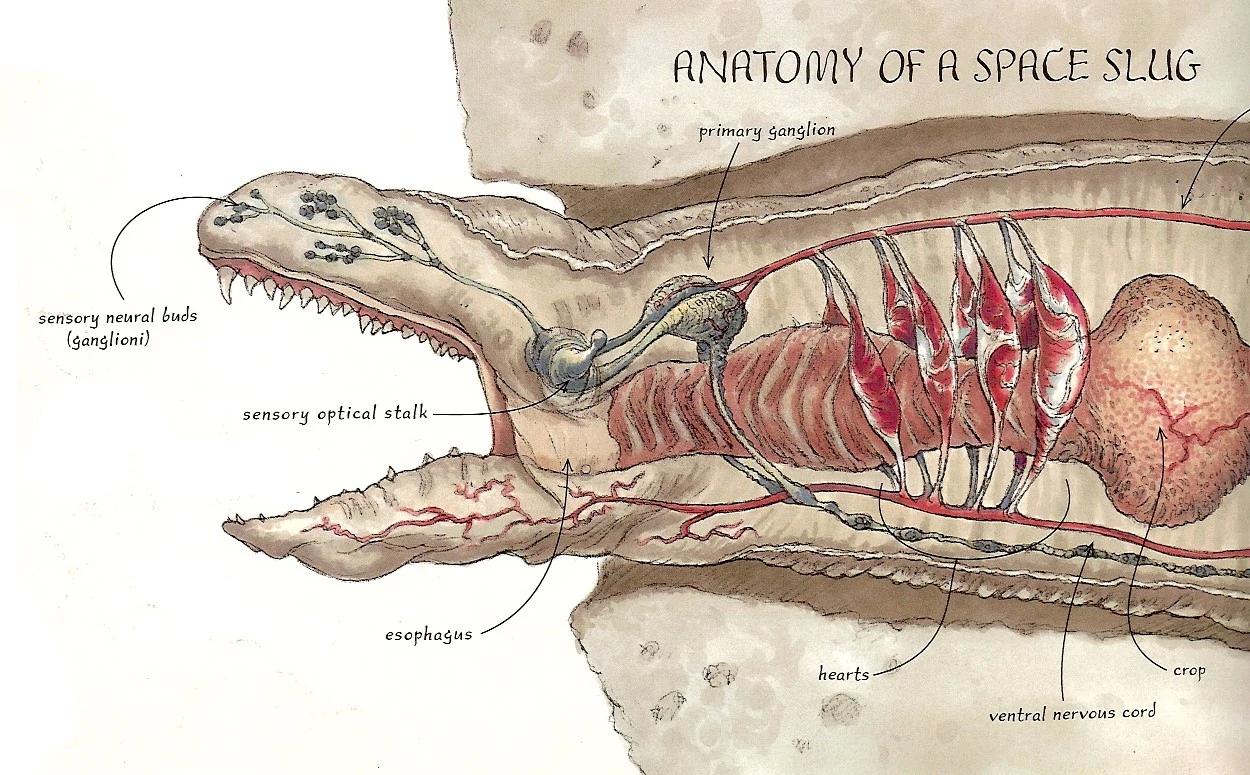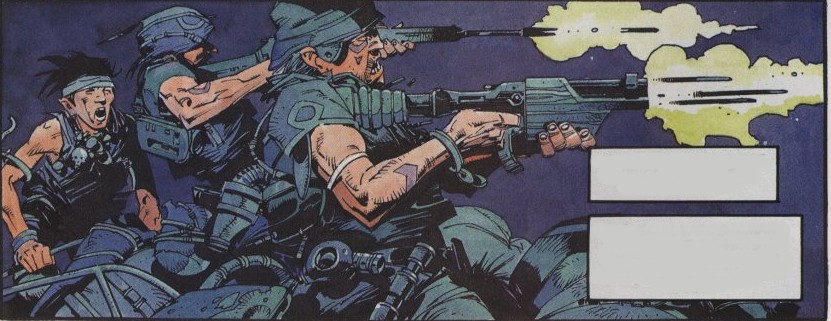 Name: Exogorth
Type: Vacuum predator
DEXTERITY 2D
PERCEPTION ID
STRENGTH 6D (creature scale)/5D (starfighter-scale)*
Special Abilities:
Vacuum: Space slugs are native to the vacuum of space and can survive in this environment with no assistance.
Teeth: Do STR+ ID damage.
Move: 6 (creature-scale slugs only)
Size: May be as small as 1 meter long. possibly up to 900 meters long
Scale: Creature to Capital
* For a 6-meter-long and a 9OO-meter-long slug, respectively: Strength varies dramatically by the length of the slug: extremely large slugs are in the starfighter or capital class.
Description: The exogorth, colloquially known as the space slug, was a gigantic species of toothed gastropod. They were silicon-based lifeforms that survived in the vacuum of space by making their homes in the caverns and craters of asteroids. They fed on the minerals of asteroids, various stellar energy fields, mynocks (another silicon-based lifeform), ships, and other unfortunate creatures that unknowingly passed into its mouth. The average adult space slug grew to about 10 meters in length, however there had been instances of near-kilometer long specimens. Some slugs were known to continuously grow to sizes that rivaled capital ships in sheer bulk, with some weighing over a million kilograms.
Space slugs reproduced asexually by fission. Once an adult slug reached a certain size, a chemical trigger would cause it to split apart into two identical slugs. The two new space slugs would immediately become self-reliant. Space slugs also molted as a result of their growth. Occasionally, this mechanism would be overridden, and the slug would grow to monstrous sizes.
A space slug would travel through the asteroid fields they inhabited by pushing off the surface of one asteroid and floating through space to land on another. They also could use stellar winds to help propel themselves through space. Through highly evolved sense of spatial awareness, they were capable of calculating the speed, trajectory, and distance of perilous moving bodies around them. This sense of spatial acuity also aided them in hunting food. They appeared to have been able to anchor themselves into a cave in an asteroid with tendrils, which also drew nutrition directly from the asteroid itself. As a space slug did not remain in one asteroid for its entire life, it can be assumed that they could break free from their point of anchorage without causing significant injury to themselves. Although their primary diet, similar to Mynocks, was passive radiation, they did tend to chomp on rocks and metal as well.
On occasion, the naturally occurring chemical trigger would cause the space slug to kill whatever occurred near them. These oddities were known to reach sizes of nearly one kilometer in length. These colossal slugs were known to take sizable bites out of capital ships that passed too close to the slug's current dwelling, and even swallow smaller vessels whole. At these sizes, the mynocks they ate would often become internal parasites, rather than nourishment, living inside the cave-like esophagus of the slugs that ate them. Some slugs had entire ecosystems of other life living within their digestive tracts.
A natural predator of the space slug was the colossus wasp.
A number of space slug variations existed, such as the giant slug, the crimson slugs, and the Cularin slugs. Giant space slugs were larger than average ones. It remains unclear if they were a separate species from the common space slug, or just individuals larger than normally reported.
Crimson slugs were a species of space slug native to the asteroids of Tapani sector. They were distinguished by a red stripe down either side of the body.
Cularin space slugs were a variety of exogorth found in the Cularin system which proved to be comparatively easy to train. Some theorized that they were descended from a domesticated form of space slug. Other theories held that these exogorths were descended from natives to the world which formed the Cularin system asteroid belt (Oblis) before its destruction, and that these creatures survived and adapted to the void of space. They may have been related to—or the same creature as—the space worms which hollowed out the moon Eskaron.
History
The House of Adasca found a way to control the slugs, known to Adascorp scientists as exogorths, after the Great Sith War. Based on the research of Gorman Vandrayk, Adascorp was able to control the hunger drives, growth rate, and reproductive fission processes of the creatures. Arkoh Adasca placed control mechanisms and hyperdrive engines on a group of slugs and sought to sell them to the Republic, the Mandalorians, or the Revanchist faction as superweapons. With the Adascorp modifications, the exogorths could be sent through hyperspace to a specific system. Once there, their increased rate of growth and division could lead to destruction of space stations, asteroids, moons, and possibly even planets. The original exogorths could be sent to another system once they had divided, making it possible to disrupt or destroy hundreds of systems in a very short time. None of the parties who were invited to bid on these new weapons were enthusiastic about using them, however, all three were interested in making sure the weapon did not fall into the other parties' hands. Camper was able to escape and used the exogorths to kill Adasca atop of the Arkanian Legacy's bridge and then lure them out to Wild Space.
One 80-meter-long specimen was observed by the University of Sanbra in the Borkeen Belt in 22 BBY. This space slug made headlines, as it was the largest ever found by the university.
Thousands of years later, the notorious Mugaari pirate Clabburn the Elder seeded the Hoth asteroid field with space slugs, in order to protect his hidden smuggler bases. In one recorded occurrence a slug living in that asteroid field grew to a size of about 900 meters in length. It was found and officially recorded by Gamgalon the Krish who made a living by capturing these massive specimens.
The asteroid belt in the Algunnis system of the Trax sector was home to several huge exogorths.
Han Solo unwittingly hid the Millennium Falcon in a space slug of similar size when running from the Galactic Empire after the Battle of Hoth. Since exogorths insulated themselves deep inside asteroids and their own heat-generating waste, Leia Organa, Han Solo, and Chewbacca were able to survive inside the space slug with only breath masks to provide oxygen. Solo had heard stories for years of the giant slugs, and had been warned of their dangers, but he dismissed them as mere "ghost-stories".
Certain facilities that resided in space would often keep a space slug living close by to help keep the pesky mynock population down. To keep these specially used slugs from reproducing and growing to uncontrollable sizes, katrium was introduced into the creature's system on a regular basis.
|












